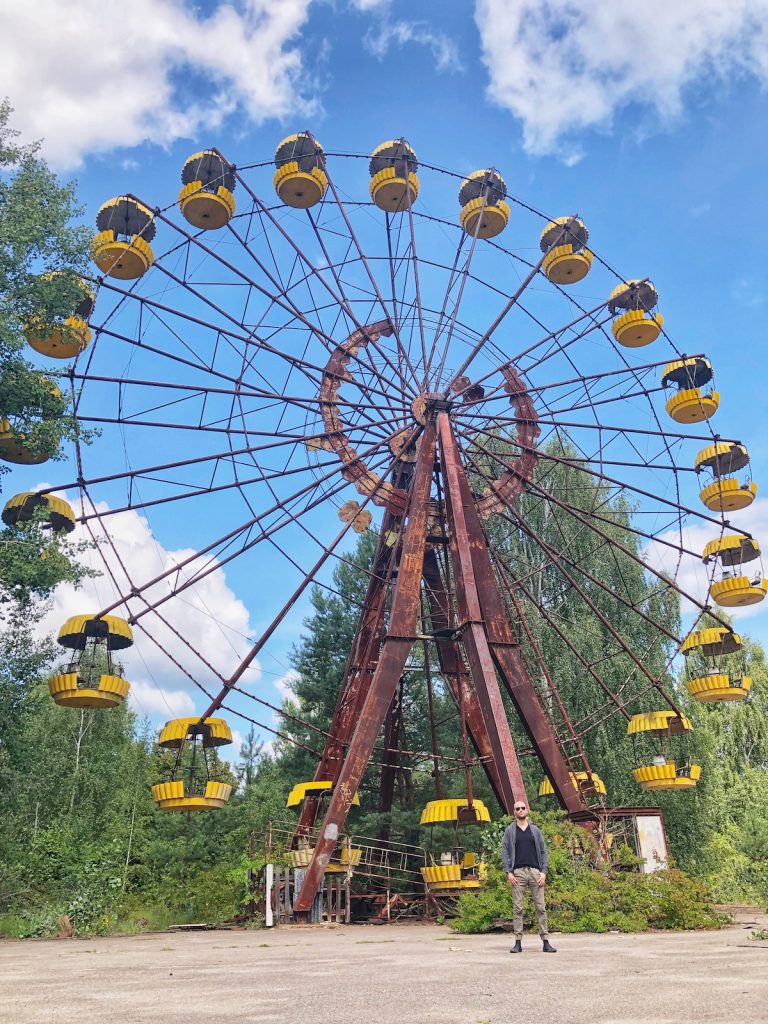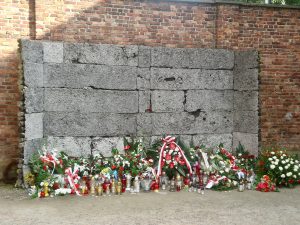Visiting Chernobyl isn’t everybody’s cup of tea for a “holiday” and it leads to a lot of questions and assumptions.
Why would you want to go there? Is it still safe? These queries get asked even more so than when I am visiting patently dangerous countries.
In recent years, HBO produced a TV miniseries about the disaster, which piqued interest in visiting Chernobyl, and shined a light on a dark period for modern-day Ukraine and its neighbouring nations.
Let’s say you ask the other type of questions.
How does one get to Chernobyl? What is it like? Will I be safe if I go?
I’ll do my very best to answer both types of questions above, as always based on personal experience, whilst attempting to use critical thinking over ego.
Edit: Due to the current war in Ukraine, life is sadly very different in the country since my visit and that should be taken into consideration before reading. I recommend this very detailed and well-written update about life in Chernobyl.
What Exactly Happened in Chernobyl?
Let’s set the scene. It’s 1986 and Ukraine is still part of the USSR (only just).
Pripyat, a small town in north Ukraine is home to Chernobyl, a nuclear power plant, responsible for producing around 10% of Ukraine’s total electricity.
In the cruellest of irony, during an experiment to test a new way of cooling the core in an emergency, the nuclear reactor experienced a surge of power causing a huge explosion. This explosion spewed huge hot lumps of graphite into the open air along with potent radioactive material.
Over the next few hours, radioactive waste poured out in the form of heat, steam and pure radiation; toxic material that was picked up from as far away as Norway and Denmark.
In true “iron curtain” style, authorities didn’t deem the explosion an emergency straight away. It was only after a fair few radiation sickness incidents and poisoning cases that the Soviet powers were forced to organise an evacuation of the city a few days later.
Since then, there have been no “legally recognised” residents in the Chernobyl exclusion zone.
Due to the dangerous levels of radioactive material that remained in the Chernobyl power plant ruins and the wider city of Pripyat, the entire area has become a modern-day ghost town.
Frozen in a freeze-frame of time, the city’s famous Ferris wheel, abandoned schools, and overgrown streets have become a symbol of eeriness and a reminder of the fall of Soviet power.
Where is Chernobyl Located?
You’ll find Chernobyl in the northern regions of Ukraine, not too far from the country’s border with Belarus. It’s very conveniently located just a couple of hours’ drive from the capital city of Kyiv, which is where you’ll need to base yourself to make a visit to this abandoned city.
Chernobyl is still considered a volatile area, with high levels of radiation and a pretty dangerous exclusion zone, so you can’t visit without an official guide. Tours are easy to organise from Kyiv, and you’ll need to set aside at least a day or two for a worthwhile visit to Ukraine’s capital while visiting Chernobyl.
If you have time, you can join a tour for two days, which includes an overnight stay (I did this and it’s one day and one night).
For the sake of understanding a usually confusing part of this story; Pripyat and Chernobyl are completely different cities. Pripyat is around 15km away, but most of the employees of the nuclear plant lived there and that’s where you see most of the famous Chernobyl landmarks online.
How Historically Accurate Was The HBO Chernobyl Drama?
Since the disaster took place, there’s been a lot of coverage on the causes and devastating consequences of the Chernobyl disaster. Some of this has been focused through a western-centric lens, while other docu-series and books have been bravely written by Russian and Ukrainian writers.
One of the newest interpretations of the Chernobyl nuclear disaster is the 2019 HBO miniseries, Chernobyl. In the mainstream media, the series was praised for its masterful production and historical accuracy in both events and the overall look of the Soviet Union in the 1980s.
Despite this, it was also met with some criticism too; critics were unhappy with how the Soviet constructs of power were portrayed. For example, the Chernobyl mini-series claims that the Soviet authorities were reluctant to seek outside help.
When, in reality, US acute radiation sickness expert Robert Peter Gale was invited to Moscow straight away. The guides seemed to be divided when I was asking all the questions while visiting Chernobyl, with some impressed by the show and others having a dig at any given opportunity.
For the most part, it seems that the HBO Chernobyl drama managed to accurately retell the events of 1986, but it’s worth keeping in mind that artistic license was definitely at play in some parts.
Do People Still Live in Chernobyl Today?
After the explosion and the delayed evacuation of Pripyat, many locals simply refused to leave the area. Just a handful of them returned weeks or months later to find their homes and rebuild their lives. Amazingly, around 150 people live in Chernobyl today, and 7,000 people in the surrounding area.
Due to the clean-up process, the site can never be completely abandoned. Security guards, maintenance workers, firefighters, and scientists work in shifts of either 15 days a month or 4 days per week to help minimise their exposure time to radiation. As for the residents of Chernobyl, most have lived into their 70s and 80s since returning and (surprisingly) have even outlived many residents who relocated.
Wildlife of Chernobyl (Mutated Animals?)
The higher powers of the USSR and Ukraine may have ordered the people of Pripyat to evacuate the town, but there was no stopping mother nature. With humanity abandoning the area, trees and foliage began to claim back the concrete and steel, turning the city into a jungle-esque wilderness frozen in time.
This drew back a bounty of wildlife back to the area, with surprising results. Levels of radiation fell as time passed and thousands of animals have returned to the area. Brown bears, wolves, lynx, bison, deer, moose, beavers, foxes, badgers, wild boar and raccoon dogs have all made the area around the city their new haven.
You may have heard reports of radiation mutating cells in animals, leaving you with images of two-headed horses and six-eyed deer. Sorry to disappoint, but you won’t come across anything of the sort during your visit.
I did see the saddest-looking, skinny little fox though, but that could genuinely happen anywhere.
Small genetic changes right after the accident, such as partial albinism in swallows or a loss of insects in the area have been noticed, but the mutant radioactive monsters of imagination are just that.
Although the long-term effects of the radiation fallout are hard to predict, the absence of human activity has provided better short-term outcomes for the wildlife of southern Belarus and northern Ukraine than could have been foreseen.
How Safe is it to Visit Chernobyl Today?
The site of one of the world’s worst nuclear disasters has to be incredibly dangerous, doesn’t it?
Actually, not so much.
Since Chernobyl has become such a tourist hotspot in Ukraine, safety measures are extremely tight, and the chances of absorbing a harmful amount of radiation are pretty slim. That’s as long as you stick to the rules…
There’s a 30km restriction zone around the Chernobyl site, and you’ll need a certified tour company to grant you a pass too. Around the nuclear accident site, there are more checkpoints where you’ll need to show your pass, so you won’t be able to wander off alone.
Other than off-limit zones with obviously fatal doses of radiation; the wider Chernobyl site isn’t as unsafe as you might think. Exposure to radiation is measured in sieverts, with a lethal dose of radiation measuring at three to five sieverts in an hour.
During your tour of Chernobyl, you’ll be exposed to around 130 to 2,610 microsieverts per hour – that’s 0.00261 of one whole sievert – this is no more than the radiation you’re exposed to during a typical long-haul flight.
With a professional tour guide showing you where to and not to go and your trusted Geiger counter to monitor radiation as you walk around Chernobyl and Pripyat, you’ll come back just as you left.
Why Would Anyone Want to Visit Chernobyl Anyway?
To many, the thought of travelling across the world to visit a site of macabre destruction and tragedy is both senseless and even to the point of being in bad taste. And yet, this pure curiosity about the negative sides of humankind and our inherited interest in the major disasters and conflicts our species has faced is something quite universal.
There are few places on this earth where a stronger example of humanity’s sudden departure can be seen. The vegetation that has swept through the town of Pripyat has a quality to it as if a lost civilisation has been stumbled upon, preserved down to the last school lessons found waiting for the children to return, which they sadly never did.
In my experience, some people seem to pick and choose what is right and wrong when it comes to where to travel, making it up as they go along with inconsistencies while hiding behind a faux-outrage and moral superiority.
There are some rather immovable critiques for visiting North Korea because pretty much all of the money goes to a brutal, totalitarian government, but I don’t see an issue with visiting Chernobyl, The Killing Fields of Cambodia, or Auschwitz.
It’s less about where we travel for me and more about how we travel (appropriate conduct for the place).
For myself, it is easy to see why thousands rush to visit the Chernobyl site each year, it is far more than morbid curiosity. As is the case with any other place where people have lost their lives, a sense of respect and caution should be adopted when visiting Chernobyl.
I personally don’t see it as “disaster porn” or simply “dark tourism,” and I think those who assume the worst of people in these situations see the world through a very dark lens themselves.
Sure, there are some people who make very bad decisions with photos in places like this, but the vast majority do not have warped minds or nefarious intentions.
Chernobyl is still a reminder of death for many and as such, should be treated with the same solemn respect you would treat a cemetery.
Charities that Support Chernobyl
Even though it’s been 35 years since the Chernobyl meltdown, the effects are still felt today in the contamination zones (Ukraine/Belarus/Russia). For this reason, there are multiple charities set up to help local residents with medical aid and quality-of-life care. Additionally, some tours donate a portion of their proceeds to Chernobyl-related charities.
- Chernobyl Children International – CCI helps children and families affected by the Chernobyl disaster through various humanitarian aid programs.
- Aid Convoy – This charity provides aid via convoys to the Chernobyl region.
- Friends of Chernobyl’s Children – FOCC provides aid (medical/dental/educational) to children that live in badly contaminated areas of Belarus. Once a year they will bring them to the UK to live for a month.
- Chernobyl Children’s Trust – CCT is run by Irish volunteers committed to helping impoverished children living in contaminated and disadvantaged areas of Belarus.
- Chernobyl Heart – This UK charity helps fund Gomel Children’s Hospital in Belarus, where many sick children require care from a desperately underfunded facility.
Can You Visit Chernobyl Without a Guide? (Includes Tour Options)
As I mentioned earlier, you can’t enter the restricted areas surrounding Chernobyl without the help of a local guide. Let’s be honest, who would want to wander around a radiation-infected city alone?
You’ll need to organise your tour at least a few weeks in advance, if not longer when you’re visiting in the peak season. This is because your tour guide will need to organise a pass for you to get through the restricted area, and this can take a while to sort out.
Booking ahead will also guarantee that you actually get a place on a tour. You’ll only need one full day to see the entire Chernobyl site, complete with a night in Kyiv either before or after. Alternatively, you can join a tour that stays overnight in the accommodation near Chernobyl.
The high season in Ukraine crashes during summer and autumn; the months of June, July, August and September. Not only is there far more foot traffic, but the weather is also at its hottest. Visit Chernobyl during the shoulder seasons of Spring and pre-Christmas, and you’ll enjoy temperate weather and far fewer crowds in the streets.
With that being said, I went in August and there wasn’t an overload of people, I am guessing there are so many allowed at one given time.
How Much Does Visiting Chernobyl Cost?
This really depends on the type of trip you’re looking for, and where you’re travelling from. If you’re already in Kyiv, then you’ll simply need to factor in the price of the tour itself. For a day tour, you’re looking at around ₴2870 or $105 USD per person. If you want to experience a night in Chernobyl, then you’ll need to fork out around double that price for a 2-day, 1-night tour.
I stayed over for one night after a full-day tour, which is referred to as a 2-day tour. My guide picked me up at the hotel and I paid 210 Euros – make sure you don’t forget your passport, as it’s obligatory.
Every single Chernobyl tour begins from Kyiv. If you’re already based in Ukraine, the handy train system will get you there pronto. Sleeper trains from the brilliant city of Lviv take around seven hours and cost between $10 and $25 USD depending on the class you choose. (If you’re after a decent amount of comfort, avoid third class, and opt for second).
Alternatively, if you’re flying into Ukraine, especially for Chernobyl, you’ll need to touch down at Kyiv’s international airport Boryspil International Airport. You’ll find direct flights here from most European capitals as well as from Georgia, Dubai and Turkey.
Those travelling to Ukraine’s capital from outside of Europe can expect to make one stop off in either London, Amsterdam or Warsaw.
There are endless places to stay in Kyiv, from top-of-the-range hotels to humble Airbnb and hostels. Fitting perfectly with the perception of Eastern European economics, accommodation in Ukraine is extremely affordable.
Some tours will pick you up from the local train station so getting accommodation here can be thoughtful, while other private tours will offer to pick you up from your hotel. (Mine did, they were called ‘Gamma Travel.’)
Safety Rules When Visiting Chernobyl
To save you from getting into trouble or causing offence, it’s worth following the safety rules set out by your tour guide. Some of these may not be obvious, but it’s good to know to avoid any weird situations like the suddenly half-naked guy who went into a restricted area and had to remove his jeans immediately.
In the Exclusion Zone, you cannot:
- Eat or smoke in the open air
- Touch any buildings or vegetation
- Sit on the ground
- Place photo or video equipment on the ground (bring protection for tripod legs)
- Take anything outside of the exclusion zone
- Violate the dress code (no open shoes, shorts, t-shirts, skirts)
- Stay in the Exclusion Zone without your certified guide
What to Wear When Visiting Chernobyl
What you wear to Chernobyl is pretty much dictated to you by the rules of the exclusion zone. You have to wear long trousers, long-sleeved tops and closed-toe shoes. The idea behind this is pretty simple; you’re about to enter an abandoned city that’s been left to the elements for three decades.
You’ll walk past exposed brickwork, broken glass, splintering wood and plenty of radioactive debris. The last thing you want is any of this getting on your skin.
Other than official requirements, it’s worth keeping the weather in mind too. In the winter months, so between December and February, temperatures in northern Ukraine can drop to as low as -12°C. If you’re visiting then, you’ll want lots of layers, a good coat, some warm gloves and a toasty hat.
Footwear is pretty important too in Chernobyl – remember that this place hasn’t been touched in 30 years. A pair of hardy walking boots would suit you best when you’re walking around the abandoned city and grounds.
As I mentioned earlier, it’s not unheard of to come across broken glass, exposed nails and all sorts of debris scattered across the streets, so having a hearty-soled shoe is a must.
My Experience of Visiting Chernobyl (Including My Overnight Stay)
The build-up to visiting Chernobyl was pretty intense. On the day of travelling to visit one of the world’s most catastrophic nuclear disasters, it’s hard to put into words any particular kind of emotion.
I’d seen the show and read stories from survivors, so I thought I might know what to expect. But nothing really sets the scene as well as experiencing the place yourself. So, I set about joining a day-plus overnight tour from Kyiv.
After meeting my tour guide and the rest of the group at a pretty sketchy roadside, we were on the road for about two hours. It didn’t take long for the high rises and busy streets of Kyiv to disappear, and the open roads and cornfields of the Ukrainian countryside to appear.
Two hours later, our tour van pulled up to the first security checkpoint, hidden somewhere in the rugged forest that surrounds Chernobyl. From this checkpoint, it’s another 10 miles until you actually get to the site of nuclear reactor number 4.
But, before we made a beeline for the scene of the crime, we made a stop off at some pretty eerie places. We started off in the main square of Pripyat, which had been completely taken over by nature.
Instead of a busy town square filled with people, there were concrete slabs that had been upturned by roots, towering trees blocking the view, and hotel signs and adverts that had faded from the building side.
Our tour guide took us down some steps and to the river – with pretty strict instructions not to touch, and definitely not to drink the water.
Away from the main square, our guide led us to the abandoned funfair – probably some of the most iconic images of the Chernobyl disaster. After seeing so many pictures of the fair, I didn’t expect this to be as eerie as it was.
But there’s something about bumper cars hastily abandoned mid-course that just doesn’t sit right. Not to mention the huge Ferris wheel that still squeaks in the wind and makes a half-arsed attempt to move.
Worse still – much of this amusement park was never actually used – Pripyat was evacuated before it could be.
After soaking up the sombre atmosphere in the “city centre”, we were driven to a small abandoned village on the outskirts of Pripyat. We stopped at what looked like a small hut, hidden in the forest.
With remnants of children’s toys, it didn’t take too long to realise this was the village school. Inside were just four rooms; one filled with rusting bunk beds, the other with faded ripped posters inscribed with the Cyrillic alphabet, and another with decapitated dolls and broken toys dotted around.
After this was the main event; a fleeting visit to the problematic reactor. Nowadays it’s contained by a giant metal dome, which should (hopefully) keep the radioactive matter contained for a good number of years. Visiting the reactor is pretty surreal, but you won’t see much – just a big metal structure from a safe distance away.
A quick photo and a higher than average reading on my Geiger Counter while taking in the feeling of place, impossible to imagine the scenes that went on during those moments.
Before you leave the exclusion zone, you’ll have to go through a radiation screening to see if you’ll take anything nasty into the “real world”. This time I got the green light and was free to go, with all my clothes intact.
There are three hotels in the Chernobyl area and I stayed at Hotel Desyatka. It had an intensely strong Soviet feel to it, which I guess is part and parcel of visiting Chernobyl.







